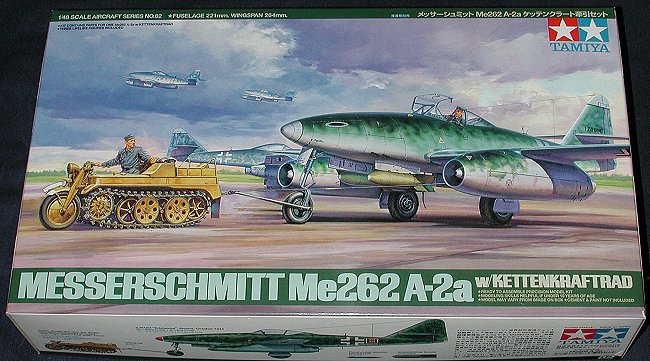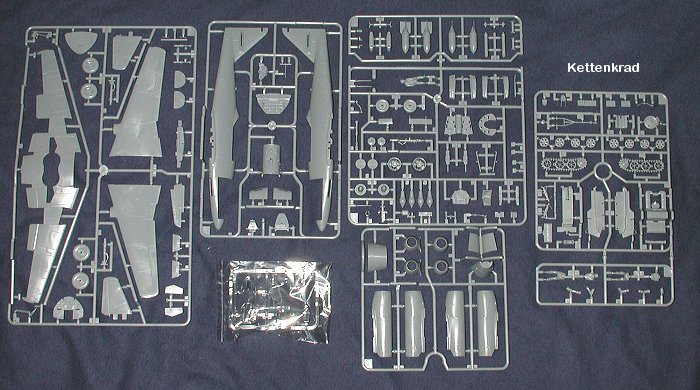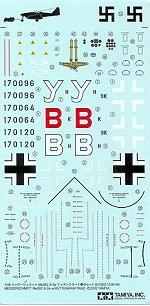
|
KIT: |
Tamiya 1/48 Me-262A w' Kettenkrad |
|
KIT # |
61082 |
|
PRICE: |
$45.00 MSRP |
|
DECALS: |
Three KG 51 aircraft |
|
REVIEWER: |
|
|
NOTES: |

|
HISTORY |
Without a doubt, the most successful turbine powered aircraft of the Second World War was the German Me-262. As with all revolutionary vice evolutionary designs, the 262 had its share of delays and problem. Most of these were due to the engines as the airframe was not only relatively conventional, but ready months before any flight ready engines were available.
Originally designed for the BMW 003 axial-flow turbojet engine, massive problems with the BMW design (mostly due to problems associated with metallurgy in the hot section), had the designers switch to the larger, but closer to ready Junkers Jumo 004.
Once the aircraft and engines were mated and somewhat reliable enough to do test flights, the improvement in performance was remarkable. An often quoted comment by Adoph Galland after he flew the plane was that it was"...like angels were pushing." The speed advantage of the 262 was often at least 100mph above what a piston engined aircraft was able to reach.
However, there were disadvantages. One was that there was no real throttle response. The pilot had to be very careful increasing or decreasing throttle settings or the engines would lose power and flame out, or quit. While the 262 could fly on one engine and glide well if both were inoperable, it had lost its speed advantage. Most 262s were shot down during landing, takeoff or during single engine operation after one had been damaged. The majority of 262 losses were in various accidents not directly related to combat. It wasn't a plane where one could hop out of a 109 or 190 and go right into flying the 262.
The engines also had very short life; initially 10 hours or less, though by the end of the war that had crept up to 25-30 operating hours. Other problems beset the 262 as well as other aircraft from lack of quality materials, rushed production, and a host of other ills as a result of the lack of centralized production. New pilots got very little training thanks to constant Allied air attacks and the general paucity of fuel. Though the 262 burned low grade kerosene, even that was in short supply in the last months of the war.
However it was a milestone aircraft in the annals of aviation. Just the threat of the aircraft was enough for the Allies to expend excess time, materiel and energy to try to blunt. Fortunately for us, there are over a dozen complete airframes in various museums around the world where we can see this famous and ground-breaking aircraft. Those wishing to know more about this aircraft only need to enter 'Me-262' into any of the various search engines. There will be a staggering number of websites listed that are devoted in one way or another to the 262.
|
THE KIT |

Nose weight not shown
Any new kit from Tamiya is eagerly anticipated. Even more so when its existence is kept pretty well under wraps until near release date. When one looks at what has been previously available in 1/48 for the 262, one does wonder why another is needed. There have been kits produced by Lindberg, Monogram and Dragon prior to this. Each additional kit a major improvement over the previous version. Even Monogram's now elderly mold is quite accurate and well detailed. The Dragon kit (also boxed by Revell AG and Italeri) was thought by many to be the ultimate in the design. It was totally accurate and when built with skill, made into a superb replica. However, its one drawback is that it is a fiddly kit and not a slap together model.
Tamiya has built a reputation in the last decade of making quality aircraft models that are superbly engineered and pretty well hassle free to build. For this very reason, many are going to overlook the premium price of the kit and eagerly delve into it. Opening the box, one discovers four individually bagged sprues with the fifth one containing a small sprue and the clear bits. One of those sprues is dedicated to the kettenkrad. Some may wonder at the inclusion of this vehicle and wish for a lower priced kit without it. I don't doubt that those wishes will come to fruition in later boxings. But for now it is a very welcome addition. Included with this sprue are the driver of the kettenkrad and a figure to sit in the cockpit as if he is the brake rider.
The kit itself offers the high quality that one comes to expect from Tamiya. There is a full cockpit with separate side consoles and instrument panel as well as the usual black boxes, control stick, seat and rudder pedals. There are decals for the instrument panel if one wants to use them. There is also a separate bomb control panel. You see, this kit is the bomber version of the 262 and not the fighter. Basically what this means is that there are a pair of bomb racks (two different designs) and bombs. It also means that there are only two nose guns and the gun cover takes this into consideration by having the upper holes closed off. Those of you thinking that "well, I'll just drill out the holes and use the other two guns" will be out of luck as the kit only comes with two! You'll have to rob a Monogram kit for the others if you want them or have documentation of a two gunned fighter version.
In addition to an open or closed gun bay, you can pose the canopy open or closed. Other options are engine covers (yay!) and rocket take-off units that were often used to get the fully laden 262s into the air. You also have a choice of nose tires; smooth or treaded. Included is a pilot figure if you do wish to man the cockpit and not have it towed. While there may be some fussing about not having separate flaps and slats, this just makes something that the resin aftermarket folks can provide to those who have a desire to spend even more $$ on their models. One thing these folks will like is that despite not having an engine, the nacelles have a full set of formers and stringers in there so that those that want to do the work won't have to add this feature. This is also carried over to the inside of the fuselage where there are not only the interior bracings, but the inside of hatches and covers are given. Perhaps in preparation for a clear fuselage version?
Another interesting change is that there are no alignment pins as we have come to expect them. The circular pin into large hole format of models from day one are gone from this kit. In its place are small tab into small slot alignment pins. These are quite shallow but perform exactly the same function as their larger brethren. I can foresee this as being a trend in kits for the future.
Detailing in the wheel wells, gun bays and cockpit are truly superb as one would expect from Tamiya. At the risk of incurring the wrath of the modeling gods, there are areas of concern. This has to do with the dreaded ejector pin marks. While they are not everywhere, they are in places that it appears you'll have to fill them as they may not be covered when the kit is built. Only construction will tell for sure. They are mostly in the landing gear area. They are on the gear struts, the insides of the gear doors and on the internal well bracing pieces. I also found them on the inside of the gun bay cover and the cockpit head armor. I know that it really is no big deal for the vast majority of us, but those who take their modeling VERY seriously; well, they will have to deal with it.
 Before I go onto the markings (as we all know how super the Tamiya instructions
are, despite their irritating tendency to list only Tamiya paints and not by
official RLM or FS numbers), I'd like to thank Tamiya profusely for their very
ingenious nose weight. It is nothing more than the nose gear well and seems to
slot into the rest of the model superbly. It really is because of thoughtful
engineering like this that Tamiya is so well regarded by most of us.
Before I go onto the markings (as we all know how super the Tamiya instructions
are, despite their irritating tendency to list only Tamiya paints and not by
official RLM or FS numbers), I'd like to thank Tamiya profusely for their very
ingenious nose weight. It is nothing more than the nose gear well and seems to
slot into the rest of the model superbly. It really is because of thoughtful
engineering like this that Tamiya is so well regarded by most of us.
There are three decal options, all from KG 51, and all in various patterns of late war light and dark green (RLM 82/83?) over RLM 76. First is 9K+B from 1./KG 51. This aircraft has a mottling of the darker green over the lighter green. This is over the entire upper surface and fuselage. Next is a 2./KG 51 262, only this time the dark green is in a series of interconnected lines giving a patchwork look to it. Finally, another 1./KG 51plane. This has the standard splinter pattern on the wings and tail sections with the lighter green on the fuselage. An intense scribble pattern in the darker green is applied to the fuselage and engine cowlings. The 1./KG 51 planes have a white nose and tail tip while the 2./KG 51 birds have a red nose. The decals themselves are typical of Tamiya. Very well printed and a bit thick. A full suite of stencils is given as are the thin demarcation lines for the nose and fin colors. Oh yes, the kettenkrad is to be painted in the sand-yellow that was often used by German armor.
A word on color. Tamiya suggests that all of the gear wells and the gun bays were unpainted. Though I know that late war aircraft were built in a bit of a rush, I can't believe that these areas didn't get at least a coat of primer on them. I can go with the inside of the gear doors being RLM 76, though even this information has taken me a while to properly accept. I'd be interested in hearing your thoughts on the subject. If you do send them in, please use the discussion board as it is a much more immediate forum.
|
CONCLUSIONS |
Well, this kit is bound to sell extremely well once it makes the hobby shop shelves. For those who can't wait, I can highly recommend the fine folks at Hobby Link Japan who can get this to you in less than a week if you wish. Were I not going to be out of town this weekend, I'd be spending it at home building this kit. From the looks of the kit, this is one that you are going to HAVE to have in your collection.
Review kit courtesy of Hobby Link Japan. Thanks for your support
If you would like your product reviewed fairly and quickly by a site that has well over 100,000 visitors a month, please contact me or see other details in the Note to Contributors.